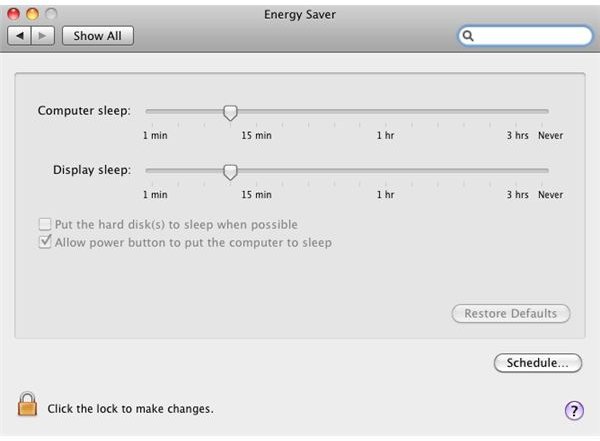Configure MacBook Sleep/Wakeup Functions
Make Your MacBook Green
More and more computer users are becoming concerned about how their use affects the environment and their carbon footprint. This is something that computer manufacturers and operating system designers have taken into account but is this enough?
Modern power management settings can be used to leave your computer on while not using any energy and Apple MacBooks are no different. This green ideal can be easily implemented, and enables your Mac to store your data before going into sleep mode.
To all intents and purposes your computer will be switched off, but can be quickly restarted and your previous work retrieved!
MacBook Sleep/Wakeup Settings
In order to automate the process – useful if you regularly leave your MacBook open while you go off and do other things – Mac OS X features some energy saving options that can be configured to suit your usage of your computer.
Available in System Preferences > Hardware > Energy Saver, these settings allow you to manage when your computer goes to sleep and when your hard disk drive goes to sleep.
Use Computer sleep to select a time delay between your last action on you Mac and the time at which it goes to sleep (the same state as closing the lid) and use Display sleep in the same way. Note that Display sleep will only turn off your display, and once you interact with your MacBook again it will be awakened.
Additional MacBook Sleep/Wakeup Options
In addition to the basic sleep options, you can also determine how your Mac goes to sleep. The first option is Put the hard disk(s) to sleep when possible, which is a good power management option that will save your current state while the computer pretty much shuts down (on waking the computer will resume your previous work). Second is Allow power button to put computer to sleep, which gives your MacBook’s power button the power to put the device into sleep mode.
If you’re unhappy with any of these choices, Restore Defaults will undo any changes you have made.
Finally, you can use the Schedule… button to set your Mac to wake up, sleep or both.
Putting Your MacBook to Sleep
As you probably know, the most basic power management option doesn’t even need to be configured. Putting your MacBook to sleep (and to wake it up again) is easily achieved by closing the lid. This will send your Mac into sleep mode, a state that uses virtually no power that can easily be resumed by opening the device again, lifting the lid/display back into position.
For most users, this is all the power management that is required. As long as the MacBook is put to sleep in this manner when not in use (you can shut down, but this really isn’t going to make much difference to your electricity bill) you can be sure that you are computing in a green manner.
